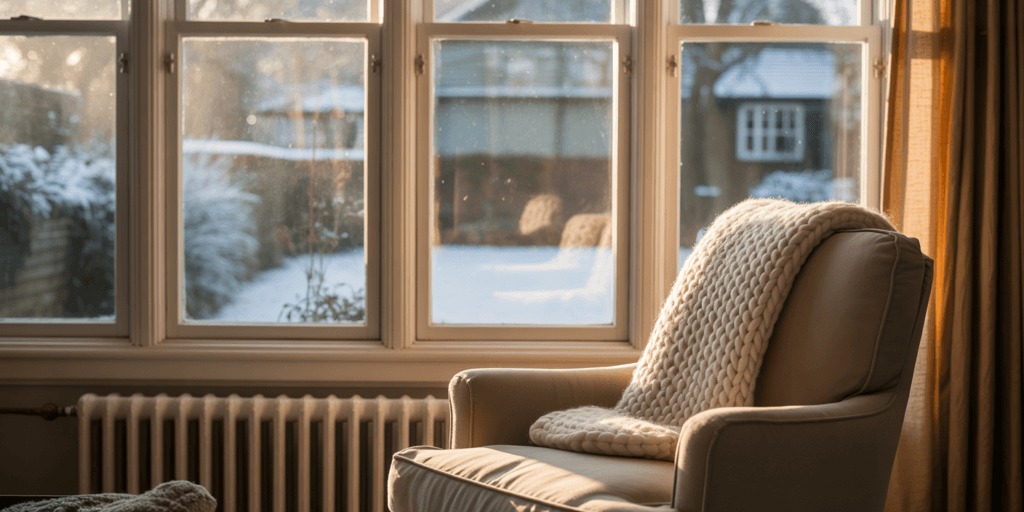Lead with the Provocative Truth (Hook)
Most homeowners assume that sash windows and Passive House standards are incompatible. They are not.
For centuries, sash windows have defined Britain’s architectural identity. Tall, elegant, unmistakably Georgian or Victorian, they remain as intrinsic to London’s character as its red buses or black cabs.
Yet beauty carries a weakness: heat loss. Poorly fitted sash windows can allow up to 30% of household warmth to escape, sending thousands of pounds out through rattling frames and thin panes each winter.
The real question is this: can heritage windows be preserved while still achieving the highest standards of energy performance?
The answer is yes. And it is already being demonstrated in homes across London.
Why Passive House Standards Matter
Passive House is not a trend. It’s a standard.
It demands windows and walls so efficient that a home barely needs heating. It’s not about gadgets or gimmicks. It’s about airtightness, insulation, and glass that works as hard as your boiler once did.
At its heart is one number: U-value. The lower it is, the less heat you lose. Passive House sets the bar at 0.15 W/m²K for the building envelope, and ≤0.8 W/m²K for windows. That’s colder air stopped in its tracks.
The benefits are immediate:
- Rooms that stay warm in winter and cool in summer.
- Energy bills cut by half or more.
- A level of comfort most homeowners have never experienced.
And it isn’t just about comfort. It’s about future-proofing. Regulations tighten every year. Buyers demand efficiency. A home that fails the energy test is a home that loses value.
That’s why Passive House matters. It isn’t for the distant future. It’s the new baseline.
And the real question is: can a sash window—born in an age of draughts and open fires—meet that standard without losing its soul?
The Heritage Dilemma

Sash windows are more than timber and glass. They’re cultural artefacts.
Walk through Belgravia, Kensington, or Hampstead, and you’ll see them in every Georgian townhouse and Victorian terrace. Tall proportions. Slim sightlines. The rhythm of London’s architecture depends on them.
But heritage is a double-edged sword. What makes a sash window beautiful also makes it fragile in a modern world. Thin panes bleed heat. Loose joints rattle in the wind. Conservation rules often forbid obvious upgrades.
For listed buildings, the dilemma is brutal: planners will not tolerate uPVC impostors or bulky triple glazing that distorts the façade. Homeowners face a choice that feels like no choice at all — comfort or authenticity.
This is the crossroads where most people stop. They believe efficiency must kill character. They fear conservation officers will reject anything modern.
But the truth is subtler, and far more hopeful. With the right materials, the right glazing, and the right craftsmanship, sash windows can satisfy both masters: the past and the future.
And that is where experience counts. Sash Windows London doesn’t just install frames. It negotiates the heritage minefield, proving to homeowners and planners alike that elegance and performance can live together.
Myths vs Reality: What’s Possible
For years, homeowners have been told the same story: sash windows can’t be efficient. The story is wrong.
Myth 1: “Sash windows can’t achieve low U-values.”
Reality: Modern slimline double and even triple glazing bring U-values down to 0.8 W/m²K and below. That’s Passive House territory. Add draught-proofing and thermally broken frames, and the numbers speak for themselves.
Myth 2: “Triple glazing ruins heritage proportions.”
Reality: Advances in glass technology—vacuum glazing like FINEO or Pilkington Spacia—deliver the insulation of triple glazing in the thickness of a single pane. Sightlines stay slim. Profiles stay elegant. The façade stays authentic.
Myth 3: “Conservation officers always say no.”
Reality: What they reject are crude replacements. What they approve are well-engineered, authentic replicas that look identical to originals but perform to modern standards. Secondary glazing, when invisible from the outside, often wins easy approval.
Myth 4: “Upgrading is too disruptive.”
Reality: Most installations are carried out with minimal disturbance to interiors. Slimline units slot into existing sash boxes. Secondary glazing installs cleanly inside. A day’s work, not months of building chaos.
The gap between perception and reality is wide. Too many homeowners live with draughts because of myths that no longer hold.
The truth is simple: you can keep the elegance of sash windows and still achieve the comfort and savings of a Passive House.
And the companies proving it—day in, day out—are the ones who know both the craft of tradition and the science of performance.
That’s where Sash Windows London lives.
The Technology That Makes It Work
Tradition doesn’t survive on romance. It survives on innovation.
Upgrading a sash window to Passive House levels of performance isn’t a trick. It’s a toolkit. Each piece works together to stop heat loss, improve comfort, and preserve beauty.
Alu-Clad and Composite Frames
Timber on the inside for heritage authenticity. Aluminium on the outside for durability and weather resistance. The marriage of two worlds keeps frames slim yet strong.
Thermally Broken Timber Frames
Heat always finds a bridge. Thermally broken sections cut that bridge in half, stopping cold from travelling through the frame. It’s invisible to the eye but decisive on the energy bill.
Slimline Triple and Vacuum Glazing
Standard triple glazing bulks a frame. Slimline triple units and vacuum glazing solve that. FINEO and Pilkington Spacia achieve triple-glazing performance at single-glass thickness. From the street, no one knows. From inside, the comfort is obvious.
Low-E Glass and Argon Fill
Coatings on the glass reflect heat back into the room. Argon gas between panes slows thermal transfer. Small tweaks. Big savings.
Draught-Proofing Systems
Every rattle, every whistle of wind, every microscopic gap is money leaving the house. Modern draught-proofing strips seal tightly while allowing smooth sliding. The sash still works. The draughts are gone.
Secondary Glazing
For listed buildings where original glass must stay, secondary glazing becomes the silent partner. Installed discreetly inside, it traps a layer of still air. Performance rises. Aesthetics remain untouched.
Each of these technologies is powerful alone. Combined, they bring sash windows within reach of Passive House standards.
And when fitted by craftsmen who understand both conservation rules and engineering detail, they do more than save energy. They protect heritage.
That is the craft Sash Windows London has made its hallmark.
Compliance Without Compromise

In Britain, windows aren’t just decoration. They’re the law.
Every installation must pass a series of regulations. They’re not optional, and they’re not negotiable. Fail them, and you risk fines, rejection, or resale problems.
Part L – Energy Efficiency
This is where heat loss meets the statute book. U-values must fall below strict thresholds. Draughts are outlawed. Airtightness is king.
Part Q – Security
Your windows must withstand forced entry. It’s no longer enough for a sash to look elegant; it must resist intrusion. Reinforced locks, toughened glass, and hardware that meet modern security codes are now mandatory.
Part K – Safety
Glazing at certain heights must be shatter-resistant. Sightlines must protect against falls. Safety, like efficiency, is woven into the design.
Local Authority Planning
In conservation areas and listed homes, approvals must pass the scrutiny of planners and conservation officers. Authenticity is inspected. Any compromise risks rejection.
This is where most homeowners hesitate. They fear a tangle of red tape. They imagine endless forms and expensive revisions.
But compliance isn’t the barrier it appears. With the right designs, sash windows can tick every box: energy, security, safety, heritage.
Sash Windows London doesn’t leave compliance to chance. Every frame, every pane, every lock is engineered to meet the standard first time. Heritage profiles satisfy conservation officers. Technical details satisfy Part L. Reinforced components satisfy Part Q.
The result? A window that passes on paper, passes in practice, and pleases both the planner and the homeowner.
Compliance doesn’t kill beauty. Done right, it protects it.
Proof in Practice: Real Homes, Real Results
Claims don’t build trust. Results do.
Take a Victorian townhouse in Islington. Original sash boxes, single glazing, and winter bills through the roof. Sash Windows London installed slimline triple-glazed units with thermally broken frames. The U-value dropped from 4.5 to 0.9 W/m²K. Bills fell by 40%. The façade? Identical to the original.
Or a Grade II listed Georgian terrace in Kensington. Planning officers refused to allow double glazing. The solution was invisible secondary glazing on the inside. The exterior stayed untouched; the interior became warm, quiet, and compliant. Approval was granted. Comfort was restored.
Infrared imaging makes the proof visible. Before: glowing red frames leaking heat. After: dark, sealed outlines holding warmth inside. One picture tells the story more powerfully than a thousand adjectives.
And then there are the words of the homeowners themselves:
- “We kept the look we loved, but the draughts are gone. The house feels alive again.”
- “For the first time, our windows satisfy both the planners and our heating bills.”
- “Visitors can’t tell the difference—but we can, every single day.”
Each project tells the same story: tradition preserved, performance transformed.
This is not a theory. It’s a lived experience. Every home upgraded proves the point again: sash windows can meet Passive House expectations without compromise.
And the company making it happen across London is the one with the evidence to show.
Conclusion
The question was simple: can traditional sash windows be upgraded to Passive House standards?
The answer is yes. Proven in townhouses and terraces across London. Proven in U-values, in thermal images, in the voices of homeowners who now live warmer, quieter, more valuable lives.
The myths are finished. The technology is here. Compliance no longer blocks progress. Heritage is not sacrificed. With the right craft, you can keep the character you love and enjoy the performance you need.
But only if you choose the company that treats every project as both an engineering challenge and a work of heritage. That company is Sash Windows London.
If you’re losing heat through history, it’s costing you money every single day. Stop it. Upgrade your sash windows now.
👉 Book your free consultation today.
Let us prove that tradition and Passive House comfort can live in the same frame.







